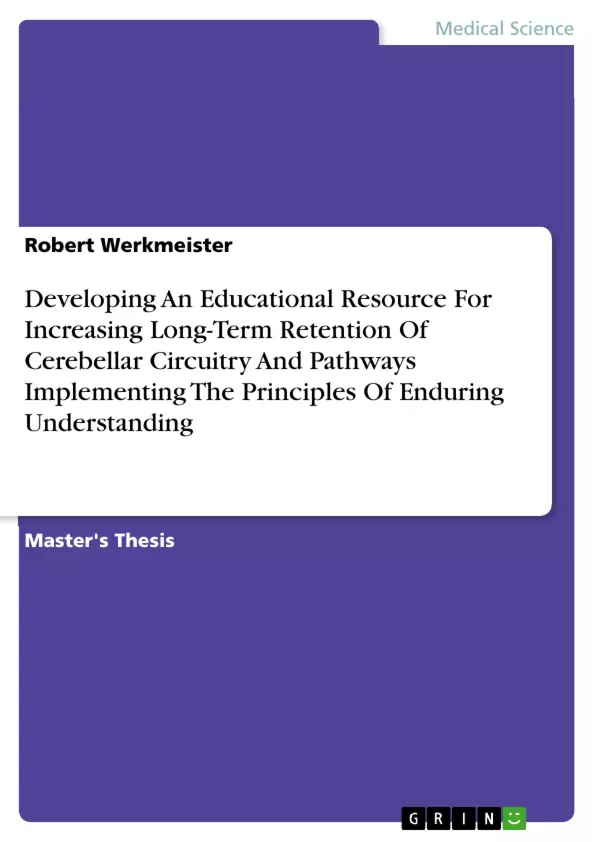This thesis focuses on implementing the educational model of enduring understanding as it applies to the visual arts and neuroscience. The thesis was designed around developing an interactive web-based flash program intended to aid in medical students’ retention of cerebellar circuitry at specific instances in their medical education. It focused on the visual and textual organization laid out within the principles of enduring understanding. By using the first two facets of enduring understanding, explanation and interpretation, the program was designed to teach medical students about the cerebellum’s structure and function. Both facets provided a framework for the organization of the text and design of the illustrations, two and three-dimensional animations and questions sections. Testing was performed on medical students at varying levels in their medical education for gaps in knowledge and usefulness. These groups included first, second, and fourth year medical students, as well as residents. Further research will test the programs effect on students’ efficiency and aptitude. Such testing will demand medical students’ involvement over four years of schooling to determine the programs full efficacy.
Inhaltsverzeichnis (Table of Contents)
- CHAPTER 1: Introduction
- Research Question
- Goal & Objectives
- Audience
- Background
- Significance
- Project Presentation
- Project Organization
- CHAPTER 2: Review of Existing Literature
- Enduring Understanding
- Introduction and Interactive Programs in Medical Education
- Enduring Understanding Principals
- The Basics of the Cerebellum
- Cerebellar Anatomy
- Cerebellar Cortex Anatomy
- Functional Divisions and Pathway Projections
- Cerebellar Peduncles
- Current Resources and Related Materials
- Images
- Interactive Programs
- CHAPTER 3: Conceptual Framework and Methodology
- Project Conceptions
- Outlining
- Research
- Final Format
- Visuals and Teaching Method
- Target Audience Goals and Objectives
- Content Organization
- Final Content Proposal
- Storyboards and Scripts
- Design
- Layout Design and Style Sheets
- Color Selection
- Visual Organization and Typography
- Menus and Submenus
- Interactivity
- Software Used in Production
- Production
- Review and Revisions
- CHAPTER 4: Results
- Evaluations
- Pre and Post Testing
- CHAPTER 5: Conclusions and Recommendations
- Conclusions
- Recommended Areas of Further Study
Zielsetzung und Themenschwerpunkte (Objectives and Key Themes)
The thesis focuses on implementing the educational model of enduring understanding in visual arts and neuroscience. The main goal is to create an interactive web-based flash program to improve medical students' retention of cerebellar circuitry throughout their medical education.
- The application of enduring understanding principles in medical education.
- The design and development of an interactive web-based program.
- The use of visuals and animations to enhance learning and retention.
- The evaluation of the program's effectiveness on students at different levels of medical education.
- The potential for future research and development in the area of enduring understanding and interactive learning tools.
Zusammenfassung der Kapitel (Chapter Summaries)
- Chapter 1: Introduction: Introduces the research question, goals, and objectives of the thesis. Outlines the intended audience and provides background information on the challenges of medical education and the emerging concept of enduring understanding. Discusses the project's significance, limitations, and organization.
- Chapter 2: Review of Existing Literature: Explores the principles of enduring understanding and their application in medical education. Examines existing interactive programs in neuroscience, highlighting their strengths and limitations. Provides a detailed review of cerebellar anatomy, function, and pathways.
- Chapter 3: Conceptual Framework and Methodology: Describes the project conception, outlining process, and research conducted to inform the program's design. Details the chosen format, visuals, teaching method, and target audience objectives. Outlines the content organization, storyboards, script development, and design process. Discusses the software used and the production process.
- Chapter 4: Results: Presents the results of student evaluations and pre/post testing of the program. Discusses the program's strengths and areas for potential revision based on student feedback.
Schlüsselwörter (Keywords)
Enduring understanding, cerebellar circuitry, interactive program, medical education, neuroscience, web-based learning, visual learning, 3D animation, student evaluation, program effectiveness, future research.
- Quote paper
- Robert Werkmeister (Author), 2009, Developing An Educational Resource For Increasing Long-Term Retention Of Cerebellar Circuitry And Pathways Implementing The Principles Of Enduring Understanding, Munich, GRIN Verlag, https://www.grin.com/document/299861



